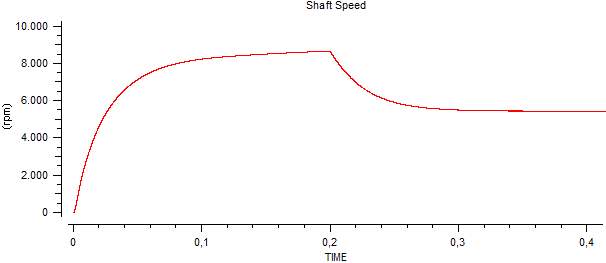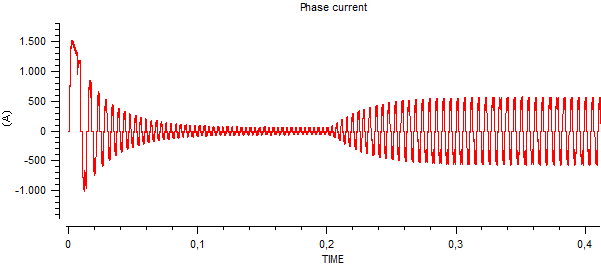ELECTRIC-SYSTEMS - Aircraft Electric System Simulation
Last Releases
1.2.2, January 2022
1.2.1, May 2020
1.2.0, March 2019
Status
Commercial toolkit, available for sale and project development
Description
The ELECTRIC-SYSTEMS toolkit provides a series of components that allow the various electrical systems of the aircraft to be modelled for More Electric Aircraft projects, both for alternating current (AC) with constant or variable frequency and for DC current. To do this, purpose-built components for these applications have been developed, such as brushless and multistage machines for constant or variable high frequency, transformers/rectifiers, power converters, protection and control systems, etc.
Features and components
ELECTRIC-SYSTEMS offers a whole set of electric, electronic and electromechanical components. Moreover, the most commonly used control algorithms are included in the library so that the user can concentrate on the areas of design and performance.
Using drag & drop methodology, the user can quickly create for study a wiring diagram whose representation is very similar to the physical system itself. The toolkit offers a wealth of possibilities, ranging from the simulation of power generation and distribution networks to transformer stations, power conversion, power electronics, typical control algorithms or digital electronic elements.
Thanks to EcosimPro/PROOSIS features, ELECTRIC-SYSTEMS is very easy to configure and extend and components and characteristics can be added as needed. This can be done graphically through a simple, user friendly interface, or using EcosimPro/PROOSIS object-oriented language which makes it possible to re-use existing codes.
Applying the object-oriented methodology, a group of components can be encapsulated into a single subsystem and used as a black box, with a defined number of inputs and outputs. This enables modular design of the overall system and makes it possible to share tasks among different specialized users or merely simplify the system.
The main features of ELECTRIC-SYSTEMS toolkit are listed below:
- Electro-mechanical systems modeling: The library provides a wide range of electro-mechanical rotating machines: The main configurations of DC Machines, Asynchronous AC machines and Synchronous AC Machines are included in the palette.
- Electric transformers in all the different configurations are also included according to the different clock indexes.
- Power electronics systems: The most common control algorithms (PWM, Space Vector, etc.) are included in the library. The main power poles and converters are also included so that the user can design the whole power electronics section of the electric system.
- Sensors, sources and basic components usually needed in electrical systems.
Aircraft Electrical System
This user case shows the capabilities of EcosimPro/PROOSIS for the joint simulation of both the propulsion system and the electrical system of an aircraft.
The model simulates the following aspects:
- Brushless three-stage synchronous generator.
- AC/DC 12 pulses Transformer Rectifier Unit.
- Low voltage AC loads, high voltage AC loads and DC loads.
- Tuned filter.
- Short-circuits at different levels.
- Selectivity protection system.
- Aircraft propulsion system.
- Constant Speed Constant Frequency Torque supply.
The following figure depicts the schematics of the aircraft propulsion and electrical system:
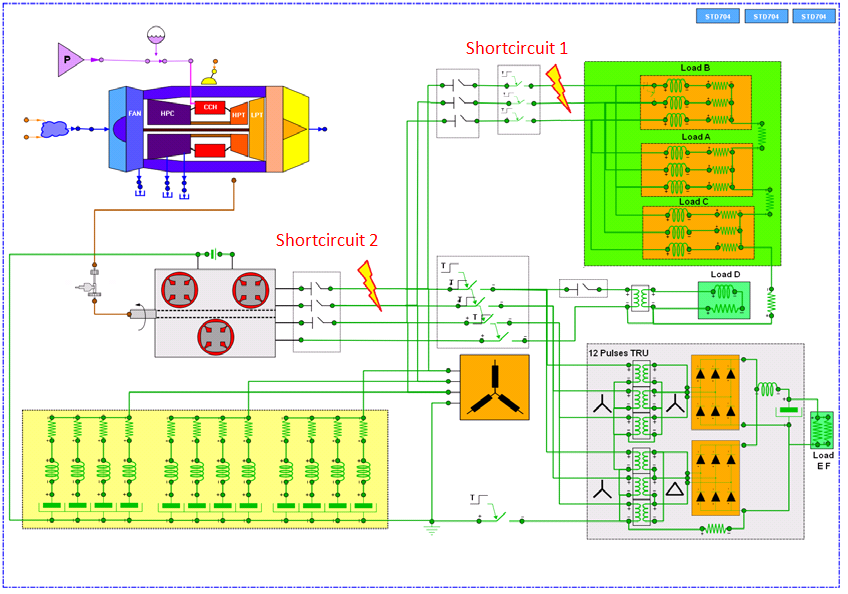
The three stage brushless synchronous generator has been modeled by means of three synchronous generators. The voltage generated in the first one is rectified and used as field excitation for the second one. In the same way, the voltage generated by the second is rectified and used as field excitation for the third. Additionally, a voltage control is used in order to regulate the excitation of the central stage and thus the output voltage. The electrical system runs at 400 Hz, with the main shaft turning at 12,000 rpm. The following figure shows the schematic modeling of the three stage brushless generator:
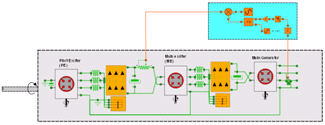
The 12 pulses TRU are modeled by means of Y/YD triphasic transformer and two passive rectifiers.
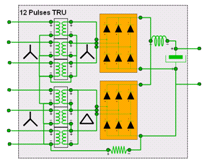
The voltage control maintains the main voltage within standard limits while the selectivity protection system allows the system to isolate the short circuit origin.
- Upstream shortcircuit: At Time = 0.5s, shortcircuit 1 is isolated at A, B and C 120V AC loads, while the rest of the circuit is still under current (TIME 0.5 to 0.7).
- Downstream shortcircuit: At Time = 0.7s, short-circuit 2 is isolated at main generator output and the whole circuit must be then protected.
Phase Voltage during generator startup and under short circuits
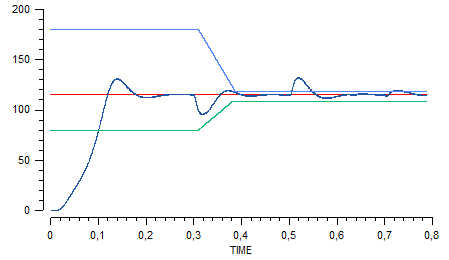
A, B and C loads phase currents
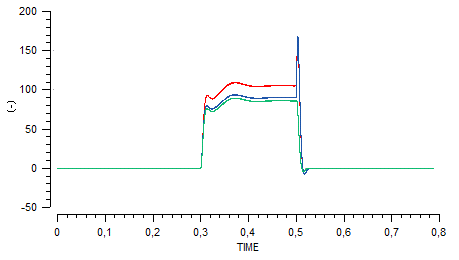
Main generator phase currents
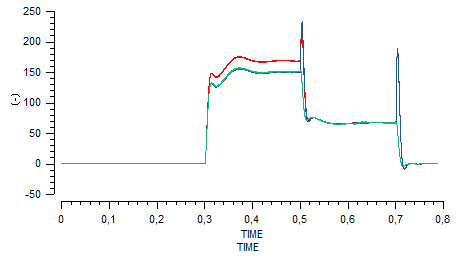
Aircraft Electric System, Brushless Motor/Generator
The startup/power generation electrical system of an aircraft is modelled. To do this, a synchronous unit with a brushless-type permanent magnet shall be used. The unit shall be powered from a distributed current source (batteries) until the assembly reaches enough speed for the main motor to reach the necessary compression to operate independently. On the other hand, once the main motors are in operation, they will be rotating the assembly. Under these circumstances, the operation of the unit shall be reversed, so that it starts operating as a generator to feed the electrical system of the aircraft.
The developed model focuses on the startup phase and its trapezoidal current control. The goal is to reach a speed of around 9000 rpm. To do this, the useful cycle required for the PWM control of the poles is established by experimentation. Modulation by pulse width provides added control: The position of the rotor establishes what transistors are active, while the PWM control makes the active transistor remain open for part of its activity and closed the rest of the time. This control may be applied in the top part of the inverter, the lower part or both. In the model that has been developed, it is applied only to the top part. Thus, the model of battery startup system with a synchronous unit with a permanent magnet developed in EcosimPro/PROOSIS with the ELECTRIC-SYSTEMS toolkit follows the figure set out below:
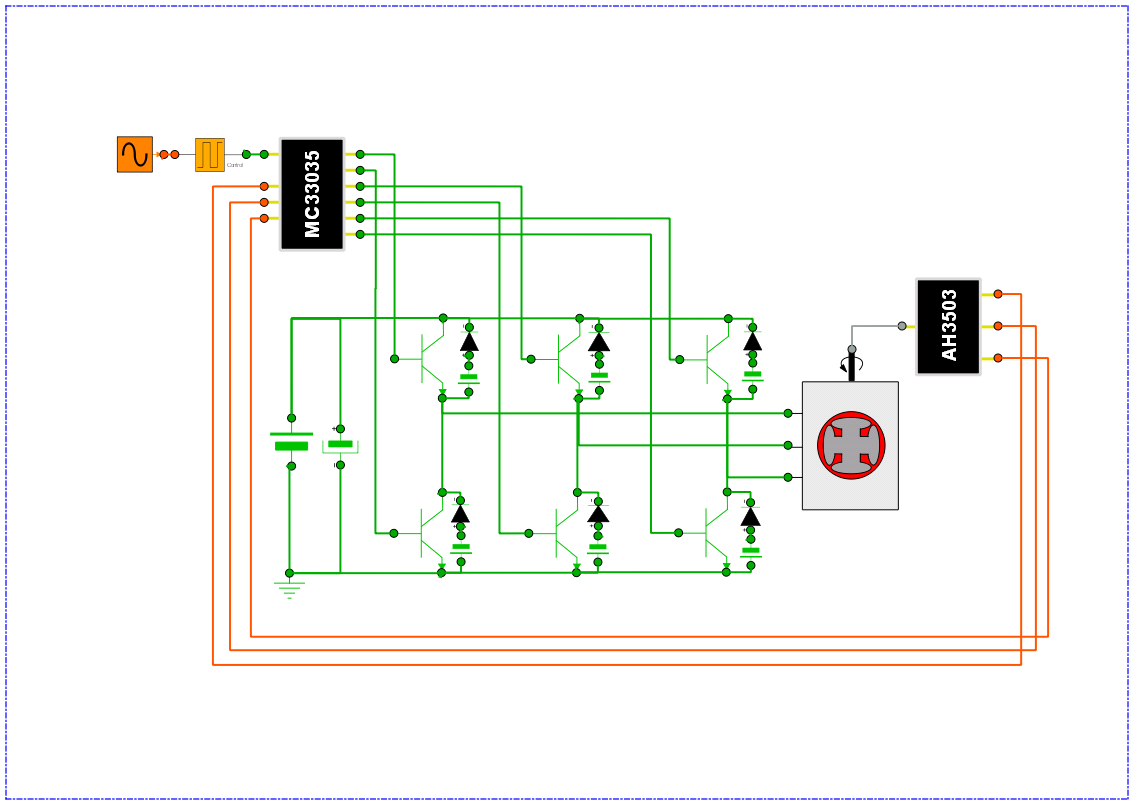
The inverter has been modelled by means of ideal transistors and diodes with a serial resistor and a given threshold voltage.
On the other hand, a Hall effect position sensor has been modelled to provide a digital 3-bit output of the rotor angular position. In addition, the trapezoidal controller applies the corresponding pulses to each pole of the inverter in accordance with the rotor position and to the corresponding PWM modulation.
Once the model has been described, the results obtained are analysed. Firstly, the evolution of the speed during startup is shown. It becomes stable at a steady state value of around 9000 rpm. The useful cycle allows the power produced by the engine, and therefore the steady state speed with a given load, to be modified. The value of 72% has been taken as definitive.
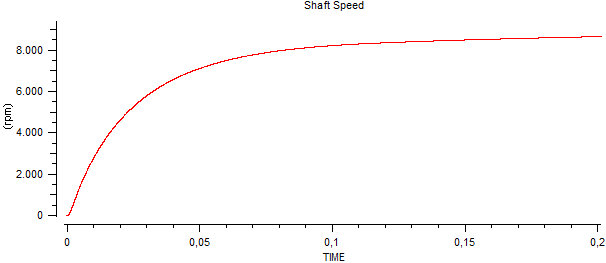
The following chart shows how the current is reduced as the unit accelerates and the induced generated voltage increase. Furthermore, the shape of the domes surrounded by flat areas of zero current coincides with the values expected with a trapezoidal control. It can be seen that each section is formed by six different sections that correspond to each of the six poles of the inverter.
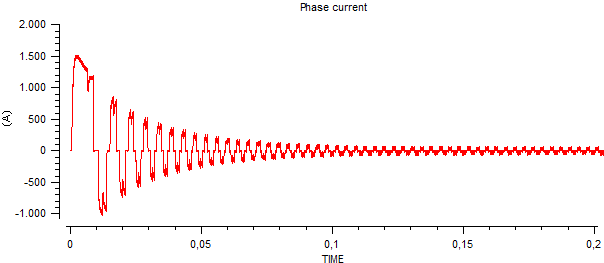
The following detailed capture shows the PWM high-frequency switching and the six switching states of a complete cycle that correspond to the six poles of the inverter:
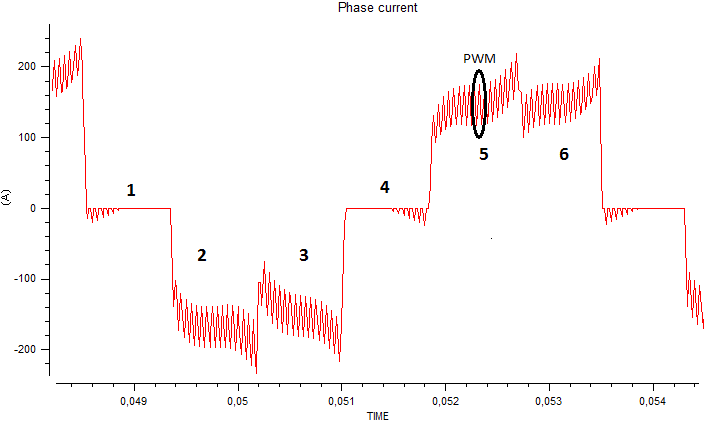
The EcosimPro/PROOSIS Monitor allows the operation of the model and its control to be studied in more detail. The chart below shows the control of the top part of the inverter with a useful cycle of 100%, while the following chart shows the control of the lower part with PWM and a useful cycle of 65%, both of them overlapping a turn of the rotor (2Π radians).
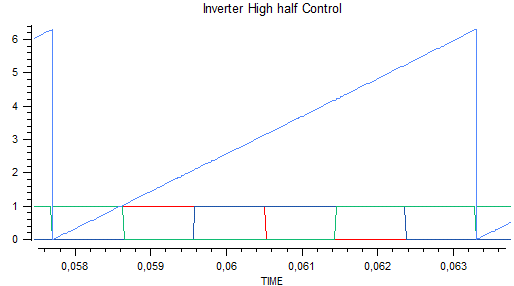
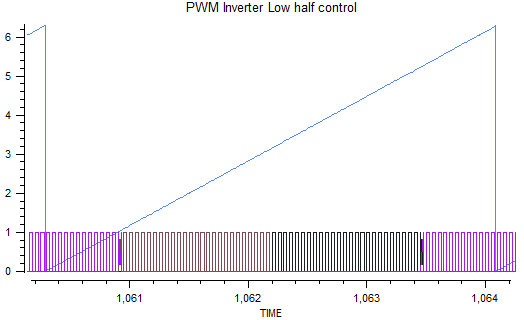
The influence of the mechanical load applied on the shaft is studied at a later stage. The simulation shows the reduction in speed and the increase in current consumption to generate the required traction capacity.
